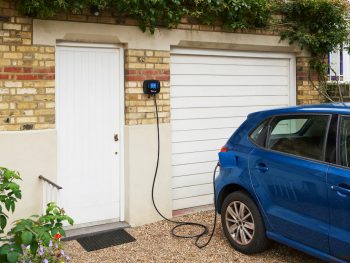Opening home and business chargers to public could plug infrastructure gaps
Making home and workplace chargers available to EV drivers via community charging could help alleviate demand and fill gaps in the public network.

Opening home chargers to the wider public will help support the shortfall in public charging points. Image credit: Ohme
Volkswagen Financial Services UK (VWFS) says using adopting such an approach will help support UK infrastructure expansion ahead of the 2030 ICE ban – although it’s stressed that government commitment and investment in charging infrastructure must continue.
Emma Loveday, senior fleet consultant at VWFS, pointed to latest statistics from Zapmap, which show that there were 45,737 electric vehicle charging points across the UK, across 26,805 charging locations, as of the end of July 2023. But there’s an estimated 10 times more installed at people’s homes and workplaces.
Some of those are already available to use by the public, but opening up more via services such as Co Charger would significantly support supply, introducing some 400,000 extra charge points to the network.
Emma Loveday explained: “Not all drivers will be able to install a home charging point. As the adoption of EVs increases, more drivers will be solely reliant on the public charging network. Introducing an Airbnb style of community charging, whereby private individuals make their own home chargers available to others when not in use, could help alleviate some of the anxiety facing EV owners and the industry regarding the speed of the infrastructure rollout.”
This could also counter the current – and significant – geographical discrepancies when it comes to charging point availability. And it would not only deliver more convenient charging for EV drivers but also cheaper charging, while enabling home charger owners to help offset the installation costs.
Such an approach could also address safety concerns held by some drivers.
Loveday continued: “In a time where we sadly see recurring headlines about public attacks of violence, especially towards women, community charging offers a solution which many will feel is a safer alternative to sitting in an isolated car park while their car charges. Being in the community, off road, near a home with people inside and lights on, and in a residential area, will feel more reassuring for a lot of people.
“Additionally, car parks statistically have a higher risk of collisions and vandalism. This risk can be reduced by parking on somebody’s drive, helping drivers having worry less about damage to their car.”
An additional phase of community charging rollout could see businesses take a similar approach to making their charge points available for other drivers to use.
“We are already seeing charging points in places such as supermarkets so you can charge while you shop,” Loveday explained. “But businesses such as gyms which have clear peak times in the morning and evening will have an empty car park in the middle of the day. They can charge a fee for use of their charge points and create an additional revenue stream for themselves, and even more choice for EV drivers.”
But she also underscored that future investment in continued public charging rollout remained essential.
Loveday said: “Community charging is not an ‘instead of’, it is an ‘in addition to’. Even if everyone with home chargers opened up access to electric vehicle users, the UK would still need major support and investment from the government to get us to where we need to be.”

